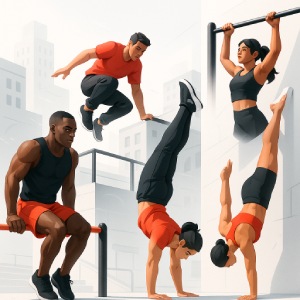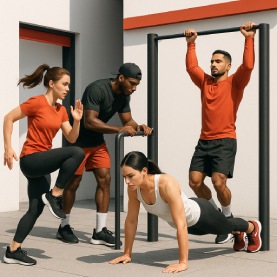The Core Principles of Street Fitness
Street fitness is centered around simple, flexible principles. The focus is on strength using mostly bodyweight exercises with an inclination towards functional movement and movement in the real world. Basically, you want to increase your body's ability to do everyday activities efficiently while also building strength, agility, and endurance.
Strength Through Natural Movement
Strength in street fitness comes from exercises involving more than one muscle at a time. Pull-ups, legs, back, and all of those are performing just that with the strength of back, shoulders, arms, and core; squats and lunges help leg strength, balancing, and stabilization. Such movements are instantaneously practical and functional.
Mobility for Better Performance
Mobility and flexibility find their way into even a single workout excessively. Through dynamic stretching and controlled rotations with a full range of motions, joints and muscles are selected and prepared for functional tasks. For example, deep lunging stretches the hips while strengthening the stabilizing muscles for increased balance and coordination.
Endurance and Cardiovascular Fitness
Street fitness builds strength and stamina. Circuit training, sprinting, and plyometric exercises are all engaging in both aerobic and anaerobic stimulation. Endurance training by way of high-rep push-ups with stair sprints or step-ups with functional strength in parallel.
Mental and Physical Synergy
Street fitness is a thing for muscle and the mind. Stumbling uneven terrain, creative adaptations, and complex movements raise the level of focus, spatial awareness, and aptitudes for solutions. Mental resilience parallels physical conditioning, making this training holistic.
Transforming the Urban Landscape

Depending on location, one of the most distinct features of street fitness is its adaptability. City streets, public parks, playgrounds, and staircases can all be considered versatile training grounds. The environment itself participates in the exercise, providing opportunities for creative thinking.
Using Everyday Objects
Simple objects can be repurposed for effective exercises: railings may serve as pull-up bars; benches for dips; swift steps can be turned into plyometric drills. Even walls give the possibility for handstand push-ups or wall squats. The key lies in recognizing the exercise options the world has to offer.
Inspiration from Street Athletes
Street fitness has gone global. Groups such as the Bar Brothers conduct advanced calisthenics on urban infrastructure, whereas outdoor gyms in cities such as Berlin and New York provide a social environment for training. These athletes remind us that in few equipment, an impressive transformation can be brought about with consistent effort, creativity, and devotion.
Essential Street Fitness Exercises
Street fitness is based on core bodyweight exercises, which can be modified to suit differing local conditions and levels.
Upper Body Exercises

- Pull-Ups: Strengthen the back, shoulders, arms, and core. Variations include wide-grip, chin-ups, and muscle-ups for advanced users.
- Push-Ups: Build chest, shoulders, and triceps. Variations include incline, decline, and plyometric, all adding challenge and versatility.
Lower Body and Core Exercises

- Squats and Lunges: Work on leg strength, stability, and mobility. Pistol squats and jump squats develop balance and control, whereas stair-based exercises up the intensity.
- Planks and Core Movements: They train the entire midsection for supporting functional strength. Side planks, hanging leg raises, and dynamic plank variations increase stability.
Explosive and Dynamic Movements

- Plyometrics: Box jumps, broad jumps, and wall jumps increase explosive power and agility. Urban elements like stairs or ledges provide added practical challenges.
- Complex Routines: Make combinations of exercises into fluid sequences, such as push-up-to-jump or pull-up-to-dip circuits. These routines build strength, endurance, and coordination simultaneously.
Progression and Adaptation
Street fitness fits the beginner and the advanced athlete. It is about gradual progression with emphasis on maintaining good form and continuously increasing the difficulty over time.
Beginner Progression
Begin with easier movements such as knee push-ups, assisted pull-ups, and step-ups. They help to build strength, mobility, and confidence to be able to progress to the unassisted variants gradually as your body adapts.
Advanced Adaptation
Once you have achieved strength at the foundational level, start working with explosive movements that combine dynamics in longer circuits. Moving the adaptations to the environment (muscle-ups on a higher bar, for example, or jump squats on uneven surfaces) will constantly challenge and improve the athlete.
Benefits of Street Fitness
The street fitness improves life from all angles-professional and interspersed with mental and social qualities.
Physical Benefits
There is also an improvement in functional strength, joint mobility, and cardiovascular endurance. Since the exercises involve the whole body, they also teach balanced muscle skills, agility, and preparedness for real-life situations.
Mental and Emotional Benefits
It is a known fact that training outdoors alleviates stress and improves concentration. This also somehow enhances mental endurance. Problem-solving during workout sessions is also good for brain function, and succeeding in hard moves boosts self-confidence.
Social and Community Benefits
Outdoor workouts to keep fit cultivate connection and being held accountable within the community. Train and work-out together to offer motivation, create a peer-learning environment, and inspire companionship. Sharing workout tips, challenges, and progress form a network of social support.
Safety Considerations

The safety aspect is absolutely crucial in street fitness. In order to prevent injuries and get the most out of it, one should always train with preparation and awareness. Remember these tips:
- Extensive warm-up: Prepare your muscles and joints with dynamic stretches and light movement before starting the exercises.
- Check out your environment: Look for uneven grounds, loose rails, slippery spots, or bits and pieces that can cause an accident.
- Happy surfaces only: Use benches, bars, and stairs that are steady and can safely bear your weight.
- No risky moves early: Muscle-ups, handstand push-ups, or jumps are for people who already have conditioning and confidence.
- Slowly and steadily: Increase repetitions, intensity, or complexity in a gradual manner so the body has time to adapt.
- Focus on form! Don't compromise technique for speed or reps, and you'll keep from straining or injuring yourself.
- Listen to your body: Stop immediately if you feel pain, dizziness, or an unusual fatigue.
With such good rules, street fitness will always be a safe, effective, and fun training experience anywhere you are.
Building a Street Fitness Routine
To be able to train street workout consistently is important for safe progression towards achieving results. Since the environment changes, it is important to plan workouts with a balance of strength, endurance, and mobility. This will also allow for variety to prevent getting bored with the same kind of training.
Structuring Your Workouts
Warm up and start doing some dynamic stretches plus light cardio, and then finish alternate upper body, lower body, core, and explosive moves. Build endurance by doing circuits or intervals, and finish with mobility and stretching to aide recovery.
Tracking Progress
Even without traditional gym equipment, tracking your performance is essential. Use With or without gym equipment, track your performance. For numbers of reps, measure of time under tension, to measure distance. Step up intensity by adding extra reps, take them to more advanced variations, or incorporate new urban features such as stairs, walls, or railings.
This way, street fitness adapts and measures so that you stay motivated toward achieving functional strength, agility, and endurance in real-world environments.
Elevate Your Workout, Everywhere You Go
In street fitness, cities serve as an opportunity for workout, creativity, adaptability, and functional strength. Endurance, mobility, and mental conditioning become the focal points by taking regular environments and transforming them into powerhouses of performance. Starting to advanced performers utilize this system for its multifaceted approach, for its accessibility, and its emphasis on the community.
With street fitness, your workout has no walls nor tools accommodating it — it's on the streets and in the parks. Every bench, railing, or flight of stairs can serve as equipment to stimulate your body, environment, and improve performance while helping you bond with your surroundings. Street fitness is functional, adaptable, and an interface for human interaction, shifting paradigms for how we move, train, interact, and live. Learn more at 3RUN.